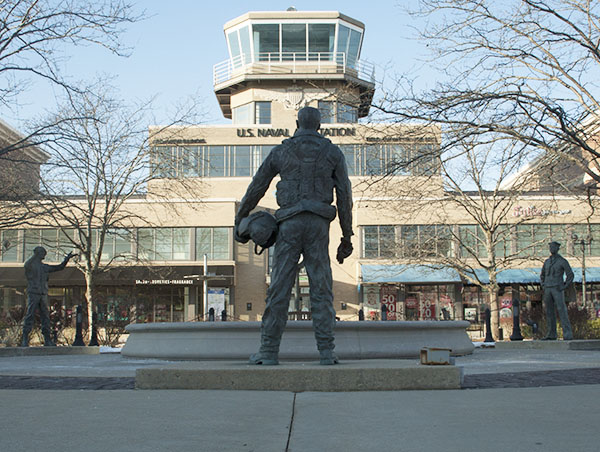Teachers reflect on retired Glenview Air Station base

Standing in front of the retired Naval Air Station, a statue overlooks retail shopping stores that replaced the previous building. A memorial commemorating the men and women that served at the station now stands across the street in the Glen Town Center.
December 22, 2017
Growing up in Glenview’s Swainwood neighborhood, David Schoenwetter, social studies teacher, listened to planes taking off and landing just past Lake Avenue. On occasion, a Goodyear blimp brought in for a Bears game would cover the sky. In the summer days leading up to Chicago’s Air and Water Show, he watched jets practice their formations over the community.
“I think that was part of my parents’ excuse for never wanting to go downtown for the show,” Schoenwetter said. “They could say, ‘Well, just look up from the backyard and you can see it here.’”
The Naval Air Station Glenview (NASG) operated from 1937 to its decommission in 1995. According to Beverley Dawson, Hangar One Foundation historian, the area was originally designated to become Chicago’s major airport. However, it was dedicated nine days before the stock market crash in 1929 and was not used.
Dawson says the Naval Aviation Program leased the northern three-fifths of the property, leaving the rest for civilian use. In response to the Pearl Harbor bombing and subsequent national mobilization, Dawson says within seven months, runways were expanded, barracks were built, and the base became “a little city within a village.”
Specifically, NASG housed a Carrier Qualification Training Unit, which trained pilots vital to World War II efforts in the Pacific.
“There wasn’t another place during WWII that trained the number of pilots we needed,” Dawson said. “[Those pilots] saved our bacon.”
Following the war, Dawson says Glenview was a reserve training sight. In 1946, the Naval Air Station became the headquarters for Navy and Marine aviation. Glenview planes delivered supplies during the Berlin Airlift, returned wounded soldiers during the Vietnam War and trained Army and Navy squadrons that served in the Korean War.
Dawson says the NASG’s existence touched the community through the people who lived and worked there interacting with civilians.
Science teacher Brandon Tucker grew up in Glenview during NASG’s operation. One of his childhood best friends, who later moved, lived on the base. In order to visit, Tucker says he went through a gate and extra precautions before being permitted entry.
“It wasn’t just a gate you’d see at a residential community,” Tucker said. “There was a guard, an armed guard at a gate to let you in.”
Tucker says it was interesting seeing the Naval Air Station while growing up in Glenview because it didn’t fit in at first glance. He visited his friend and played with other children on the base in an environment that differed from the usual Glenview play areas.
“We’d play games on what you’d call their ‘park area,’” Tucker said. “It was just a field, but we’d call it a park and we’d be running around there.”
Schoenwetter says he visited the base on days where doors would open to the public to watch planes.
“You’d always see the base through the fence with barbed wire around it, running along the perimeter, it was always kind of a mystery as to what was going on out there,” Schoenwetter said.
Evanston-resident and stage director Rich Winship felt the NASG’s presence from working in Glenview. Like Schoenwetter, Winship says he heard planes taking off and saw the station from various spots in the community.
Winship says the children of NASG personnel brought interesting perspectives from moving frequently. Tucker says he formed friendships with children like this who lived in NASG. He says they would stay for a couple years before moving across the country or world.
“One of my best friends moved away when I was in eighth grade to the Middle East with his family,” Tucker said. “To think about that as an experience is interesting. It’s probably different from what most of us have.”
Today, the Glen Town Center and residential communities occupy land previously taken by the NASG. The control tower and Hangar 1 remain standing.
Schoenwetter said, “I think we’re probably getting to the point where if this generation doesn’t learn about it, the next generation won’t. It’s really important that kids learn about the history of the base because it’s an important part of the history of our town.”


